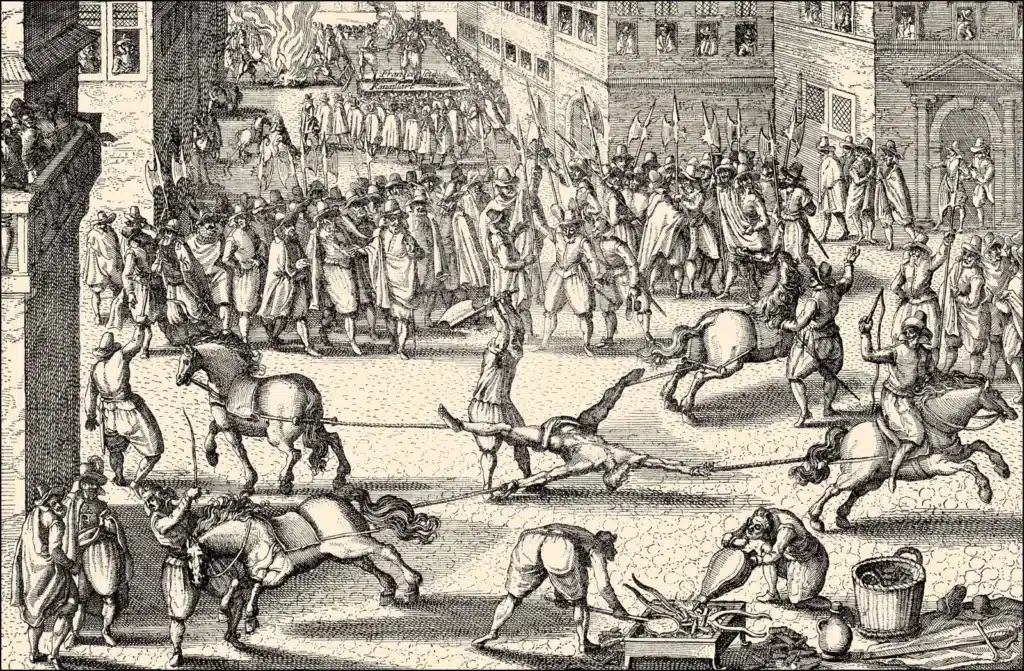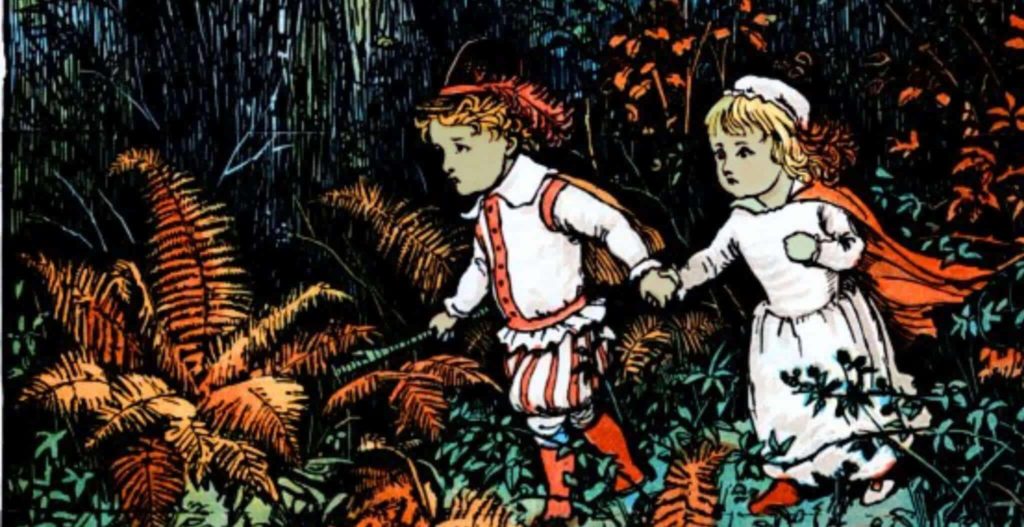For centuries, England was notorious for its brutal and inhumane form of execution known as “hanging, drawing, and quartering”.
This gruesome punishment was reserved for the most heinous crimes and involved a series of torturous steps to leave its victims mutilated and dismembered. Intending to be horrific, to be hanged, drawn, and quartered is considered to be the epitome of “cruel and unusual punishment,” which we now strive to avoid,
How did this barbaric practice come to be, and why were its methods used for so long? To answer this question requires taking a closer look at the history of this particularly extreme form of the death penalty, and exploring its origins, its grisly procedures, and the cultural impact it left.

A Grisly, Disturbing Punishment
In Elizabethan England, high treason warranted the death sentence. The death sentence consisted of hanging, drawing, and quartering – a brutal method of execution that was unfortunately normal for the times. This hard and public method was used to instill fear in the people and loyalty to the monarchy.
The process was typically conducted almost entirely in public – for example at a popular market or town square. It began with the criminal first being tied to a wooden panel or hurdle, and drawn by horse to the place of execution. Once there, the traitor was hanged – but importantly, not to the point of death. Then, the victim, still alive, was ‘emasculated’, disemboweled, beheaded, and quartered.
Public mutilation was horrific and involved disembowelment – by which their intestines would be physically removed. And also castration, where their entrails and genitalia were burned before them afterward. Such disfigurement and bodily shock often proved too much for the victim to handle and lead to their death.
This was all then followed up by ‘quartering’. Quartering involved tying the victim’s limbs to four horses, which were then spurred to run off in different directions.
Gibbeting, a practice of subsequently displaying the remaining body parts in public, was also common, the point being to deter potential traitors. The severed head was often sent to the Tower of London, while other body parts were exhibited in prominent locations like city gates, or even London Bridge.
Initial Origins and the Treason Act
The practice of hanging, drawing, and quartering seems to have started in 1241 to punish the pirate William Maurice. However, some sources cite an earlier instance in 1238.
Easily the most well-known of these first instances was the fate of the infamous Welsh prince David ap Gruffudd – sentenced to drawing and quartering in 1283 on the King’s authority for numerous crimes. Intended to be harsher than any other punishment, he was drawn for treason, hanged for homicide, disemboweled for sacrilege, and finally, beheaded and quartered for scheming against the King.
Another supposed traitor, the Scottish resistance leader Sir William Wallace, was killed in 1305 in the same appalling manner.
Eventually, hanging, drawing, and quartering was codified in British law as a penalty for high treason by the king’s enemies in the Treason Act of 1351 under the reign of King Edward III. Other, lesser forms of treason, such as petty treason also carried a punishment of being hanged and drawn. Notably, the law did little to limit the king’s ability to define what constitutes treason.
Hanging, Drawing, and Quartering in English Society
After becoming statutory law, hanging, drawing, and quartering persisted as a punishment for centuries in English society.
Some of the most high-profile cases that resulted in this extreme penalty include that of William Wallace, as previously mentioned, as well as William Collingborne, a writer found guilty of treason in 1484.
Collingborne’s crime was simply writing the rhyming couplet, “The cat, the rat and Lovel our dog, Rule all England under the hog,” which the king did not take kindly to. Others, like Guy Fawkes and the conspirators of the Gunpowder Plot, were famously sentenced in 1606.
It is likely that hundreds, if not thousands, of men convicted, were hanged, drawn, and quartered over the centuries. It’s worth noting that a woman convicted of high treason was instead burned at the stake to preserve public decency, so this particularly heinous punishment was reserved for male traitors only.
Nearly all of the executions were carried out in public, with crowds of people, sometimes tens of thousands deep, gathering to witness the gruesome spectacle.
Public Critique and Legal Abolition
Instances of this punishment continued well into the late 1700s and the early 1800s. It’s challenging to discern exactly when was the last time it was carried out, however.
Notable victim David Tyrie was sentenced and killed in 1782 for being a French spy, while the likely final case took place in 1803 when Edward Despard and six co-conspirators were sentenced to face this punishment.
From the late 18th century onward, many politicians, like William Wilberforce and Samuel Romilly, worked to reform England’s capital punishment laws. Burnings were now seen as particularly grotesque, and public opinion was shifting against the practice of executing women in this way. The Treason Act of 1790 would change women’s punishment for treason to hanging.
As for hanging, drawing, and quartering men, Romilly and others pushed for changes there. Still, despite the ongoing reformation of England’s capital punishment laws throughout the 19th century, it would take several decades before they achieved the abolition of this punishment.
Finally, while it hadn’t been carried out in quite some time, the Forfeiture Act of 1870 officially abolished the practice of hanging, drawing, and quartering.
Reflecting on the Grotesque Punishment
While hanging, drawing, and quartering was abolished in the 19th century, its legacy still lingers. The brutality of this punishment, and the spectacle that surrounded it, was a reminder of the power of the state, and the grisly consequences of defying it.
Today, we look back on this practice with horror. Its abolition was a crucial step in the evolution of English law and justice.
References
“David Tyrie – 1782.” British Executions, http://www.britishexecutions.co.uk/execution-content.php?key=8028&termRef=David+Tyrie.
“Drawing and Quartering.” Encyclopædia Britannica, Encyclopædia Britannica, Inc., https://www.britannica.com/topic/drawing-and-quartering.
“Drawing and Quartering.” New World Encyclopedia, 14 Aug. 2020, https://www.newworldencyclopedia.org/entry/Drawing_and_quartering.
Mortimer, Ian. “Why Do We Say ‘Hanged, Drawn and Quartered?’.” Ian Mortimer, https://www.ianmortimer.com/essays/drawing.pdf.

